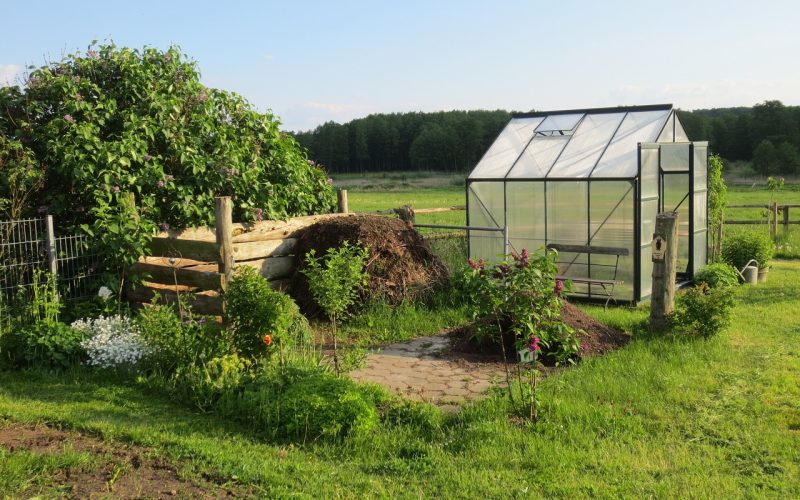When it comes to maintaining the optimal conditions for your greenhouse, keeping it cool is just as important as ensuring sufficient warmth.
Understanding the importance of greenhouse cooling and the factors that affect greenhouse temperature will help you create a comfortable environment for your plants to thrive.
Understanding the Importance of Greenhouse Cooling
Greenhouse cooling plays a vital role in creating a favorable environment for plant growth.
Excessive heat can lead to plant stress, wilted foliage, and even damage or death in extreme cases.
By implementing effective cooling strategies, you can regulate the temperature and provide your plants with the ideal conditions they need to flourish.
Proper greenhouse cooling not only helps to maintain a comfortable temperature but also controls humidity levels.
High humidity can promote the growth of fungi and other pests, which can harm your plants.
Managing the temperature and humidity can create a healthier and more productive greenhouse environment.
Factors Affecting Greenhouse Temperature
Several factors can affect the temperature inside your greenhouse. It’s important to be aware of these factors to better understand how to cool your greenhouse effectively.
Here are some key factors to consider:
- Sunlight and Solar Radiation: The amount of sunlight and solar radiation that enters your greenhouse can significantly impact its temperature. Shading techniques, such as using shade cloth or sunshades, can help reduce the amount of direct sunlight and mitigate heat buildup.
- Ventilation: Proper ventilation is crucial for greenhouse cooling. Adequate airflow helps remove hot air and circulate fresh, cooler air. Natural ventilation methods, such as ridge vents, side vents, or louvers, can be used to facilitate air exchange. Mechanical ventilation systems, such as fans or exhaust fans, can also be employed for enhanced airflow.
- Insulation and Greenhouse Design: The insulation properties of your greenhouse and its design can affect temperature regulation. Well-insulated structures with appropriate glazing materials can help retain cool air during hot periods. Consider using materials with high insulation values and proper sealing to minimize heat transfer.
- Geographical Location and Climate: The geographical location of your greenhouse and the prevailing climate in your area can impact the temperature inside. Hotter climates may require more cooling efforts, while cooler climates may necessitate additional heating during certain seasons. Understanding your specific climate conditions will help you determine the most effective cooling strategies.
By considering these factors and implementing appropriate cooling methods, you can create a comfortable and conducive environment for your greenhouse plants.
Explore natural cooling methods such as ventilation, shade cloth, evaporative cooling, and mechanical cooling methods like fans, air conditioning units, and fogging systems.
Don’t forget to regularly monitor the temperature and humidity levels to ensure optimal conditions for your plants’ growth and well-being.
Natural Cooling Methods
When it comes to keeping your greenhouse cool, natural cooling methods can be highly effective and environmentally friendly.
These methods utilize natural elements to regulate the temperature inside your greenhouse.
Let’s explore three common natural cooling techniques: ventilation, shade cloth and sunshades, and evaporative cooling.
Ventilation
Proper ventilation is essential for maintaining a cool and healthy greenhouse environment.
By allowing air to circulate, you can prevent heat buildup and promote fresh airflow.
Ventilation can be achieved through various methods, such as using vents, doors, and windows or installing exhaust fans.
Strategic placement of vents and fans helps to create a cross breeze, drawing in cool air from one side and expelling hot air from the other.
This circulation helps regulate the temperature inside the greenhouse, preventing excessive heat buildup.
Remember to monitor the temperature regularly and adjust the ventilation openings accordingly to maintain an optimal climate.
Shade Cloth and Sunshades
Shade cloth and sunshades are effective tools for reducing the amount of direct sunlight that enters your greenhouse.
These materials are designed to block a certain percentage of sunlight, thereby reducing heat intensity and preventing plants from overheating.
Shade cloth is typically made from a woven or knitted fabric that provides varying degrees of shade.
The percentage of shade is denoted by a number such as 30%, 50%, or 70%, indicating the amount of sunlight it filters out.
It’s important to choose a shade cloth that suits the needs of your plants and the climate in your region.
Sunshades, on the other hand, are solid coverings that attach to the outside of the greenhouse structure.
They can be made from materials like shade netting or opaque panels. Sunshades are adjustable and can be positioned to block the sun’s rays during the hottest part of the day.
By incorporating shade cloth or sunshades into your greenhouse, you can provide your plants with relief from intense sunlight and help maintain a cooler growing environment.
Evaporative Cooling
Evaporative cooling is a natural cooling process that utilizes water evaporation to reduce the temperature inside the greenhouse.
This method takes advantage of the fact that when water evaporates, it absorbs heat from the surrounding environment.
To implement evaporative cooling, you can use techniques such as misting or fogging systems.
These systems spray a fine mist or fog of water into the greenhouse, which evaporates and cools the air.
The evaporative cooling effect is most significant in dry climates where the water can evaporate quickly.
It’s important to note that evaporative cooling may increase humidity levels inside the greenhouse.
This can be beneficial for certain plants, but it’s essential to monitor the humidity levels and ensure they remain within the optimal range for your crops.
By utilizing natural cooling methods like ventilation, shade cloth and sunshades, and evaporative cooling, you can maintain a comfortable and favorable environment for your plants.
These techniques work in harmony with the natural elements, providing an efficient and sustainable way to cool your greenhouse.
Mechanical Cooling Methods
When it comes to cooling your greenhouse, mechanical cooling methods can be highly effective in maintaining optimal temperature and humidity levels.
These methods utilize various equipment and systems to actively circulate air and reduce heat buildup.
Let’s explore three common mechanical cooling methods: fans and ventilation systems, air conditioning units, and fogging systems.
Fans and Ventilation Systems
Fans and ventilation systems are fundamental components of greenhouse cooling.
They help to circulate fresh air, remove stagnant hot air, and provide adequate ventilation.
By strategically placing fans and utilizing intake and exhaust vents, you can create a continuous airflow that prevents heat buildup and promotes proper plant transpiration.
To achieve the best results, consider the size and layout of your greenhouse. Proper fan placement is crucial for efficient air movement.
Additionally, installing adjustable vents allows you to control the direction and speed of the airflow.
By adjusting the fans and vents, you can fine-tune the temperature and humidity levels, ensuring an optimal environment for your plants.
Air Conditioning Units
Air conditioning units are an effective cooling solution for larger or climate-controlled greenhouses.
These units actively remove heat and dehumidify the air, creating a comfortable and controlled environment for your plants.
Air conditioning units are particularly beneficial in regions with high ambient temperatures or when precise temperature control is necessary.
When selecting an air conditioning unit, consider the size and cooling capacity required for your greenhouse.
It’s essential to choose an energy-efficient unit that can adequately cool the space without excessive energy consumption.
Regular maintenance and cleaning of the unit are also important to ensure optimal performance and longevity.
Fogging Systems
Fogging systems provide a unique method of greenhouse cooling by utilizing the principle of evaporative cooling.
These systems release a fine mist of water droplets into the greenhouse, which evaporates and cools the air.
The evaporative cooling effect helps to lower the temperature and increase humidity, creating a favorable environment for plants.
Fogging systems can be particularly useful in hot and dry climates.
They are often used in conjunction with other cooling methods to maximize the efficiency of the cooling process.
It’s important to monitor the humidity levels to prevent excessive moisture buildup, which can lead to plant diseases or mold growth.
By incorporating these mechanical cooling methods into your greenhouse, you can effectively regulate the temperature and create an optimal growing environment for your plants.
Remember to monitor the temperature and humidity levels regularly, and make adjustments as necessary.
For more information on greenhouse basics, check out our article on what is a greenhouse and how does a greenhouse work.
Creating an Effective Cooling Strategy
When it comes to cooling your greenhouse, it’s important to create an effective strategy that takes into account the unique needs of your plants and the specific conditions in your greenhouse.
Here are some key considerations to help you develop a successful cooling plan.
Monitoring Temperature and Humidity
To effectively cool your greenhouse, you need to closely monitor the temperature and humidity levels inside.
Invest in a reliable thermometer and hygrometer to accurately measure these variables.
Understanding the ideal temperature and humidity ranges for your plants will guide your cooling efforts.
Regularly check the readings and make adjustments as needed.
If the temperature rises above the desired range, it’s time to implement your cooling methods.
Similarly, if humidity levels become too high, you may need to adjust your ventilation or use dehumidifiers to maintain optimal conditions.
Timing and Scheduling Cooling Methods
Timing is crucial when it comes to cooling your greenhouse.
The intensity of the sun and outdoor temperatures vary throughout the day, so it’s important to schedule your cooling methods accordingly.
In general, it’s best to start cooling early in the day before temperatures peak.
Open vents, turn on fans, and activate any mechanical cooling systems you have in place.
By taking proactive measures, you can prevent excessive heat buildup and keep the greenhouse environment comfortable for your plants.
Combining Natural and Mechanical Cooling Techniques
To maximize the effectiveness of your cooling strategy, consider combining natural and mechanical cooling techniques.
Natural methods like ventilation, shade cloth, and evaporative cooling can be complemented by mechanical methods such as fans, air conditioning units, and fogging systems.
For example, during the hottest parts of the day, you can rely on mechanical cooling methods to rapidly reduce the temperature.
Once the temperature cools down in the evening, you can switch to natural cooling methods to take advantage of cooler outside air.
Experiment with different combinations of natural and mechanical cooling techniques to find the optimal balance for your greenhouse.
Remember to consider factors like the size of your greenhouse, the type of plants you’re growing, and the local climate when determining the most effective cooling approach.
By monitoring temperature and humidity, timing your cooling methods, and combining natural and mechanical techniques, you can create an effective cooling strategy for your greenhouse.
Remember to adjust your plan as needed based on the specific needs of your plants and the changing weather conditions.
With a well-executed cooling strategy, you can ensure a comfortable and thriving environment for your plants all year round.
Additional Tips for Cooling Your Greenhouse
To keep your greenhouse cool and comfortable for your plants, there are additional tips and practices you can implement.
These include focusing on insulation and energy efficiency, watering and irrigation practices, and plant selection and layout.
Insulation and Energy Efficiency
Proper insulation and energy-efficient measures can play a significant role in maintaining a cooler greenhouse environment.
Here are some tips to consider:
- Insulate your greenhouse: Insulating your greenhouse can help regulate temperature fluctuations. Use materials such as bubble wrap or greenhouse shade cloth to provide insulation, especially during colder months.
- Seal any air leaks: Identify and seal any air leaks in your greenhouse to prevent unwanted heat transfer. Check for gaps around windows, doors, and vents, and use weatherstripping or caulk to seal them.
- Install shade screens: Shade screens or reflective materials can be used to block excessive sunlight and reduce heat buildup. These screens can be placed on the outside or inside of the greenhouse, depending on your specific needs.
- Optimize ventilation: Proper ventilation is crucial for airflow and temperature regulation. Use vents, louvers, or fans to ensure fresh air circulation and prevent heat from stagnating inside the greenhouse.
Watering and Irrigation Practices
Proper watering and irrigation practices are essential for maintaining a cool and healthy greenhouse environment.
Consider the following tips:
- Water during cooler periods: Water your plants during the cooler parts of the day, such as early morning or evening, to minimize evaporation and reduce heat stress on the plants.
- Use drip irrigation: Drip irrigation systems deliver water directly to the roots of your plants, minimizing water waste and reducing humidity levels in the greenhouse.
- Mulch your plants: Apply a layer of organic mulch around your plants to retain moisture in the soil and prevent excessive evaporation. This can help regulate the temperature and humidity levels within the greenhouse.
Plant Selection and Layout
The selection and arrangement of plants in your greenhouse can also contribute to its overall cooling.
Consider the following tips:
- Choose heat-tolerant plants: Select plants that are naturally more tolerant to heat and can thrive in warmer environments. These plants are better suited for a greenhouse that may experience high temperatures.
- Provide proper spacing: Allow adequate spacing between plants to promote airflow and prevent overcrowding. This helps reduce humidity levels and prevents the buildup of heat around the plants.
- Consider vertical gardening: Utilize vertical gardening techniques to maximize space and allow for better air circulation. This can help prevent heat pockets and improve overall cooling within the greenhouse.
By implementing these additional tips, you can enhance the cooling efficiency of your greenhouse and create an optimal environment for your plants to thrive.
Remember to monitor temperature and humidity levels regularly and make adjustments as needed.
For more information on greenhouse-related topics, check out our articles on how to heat and cool an indoor greenhouse.








